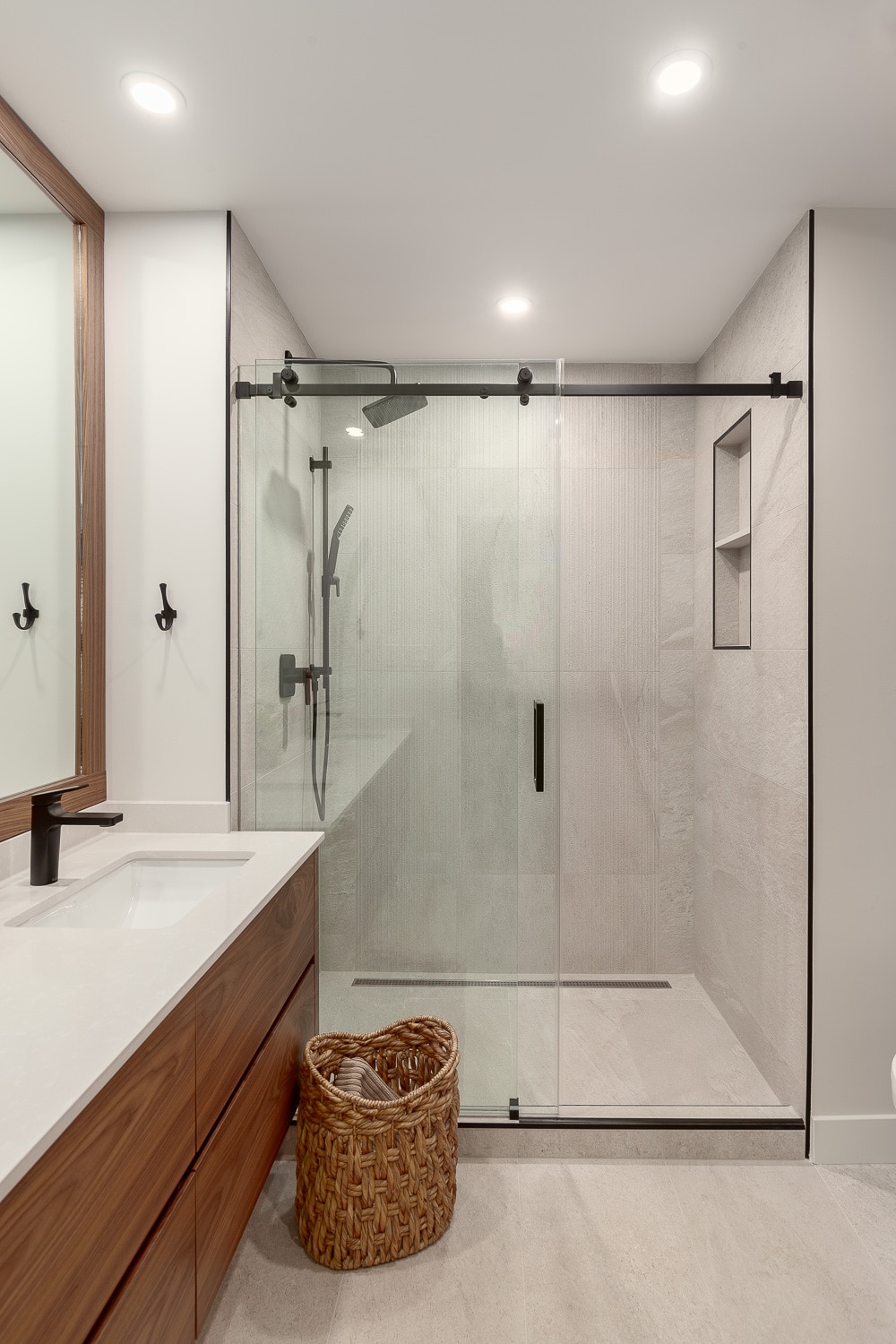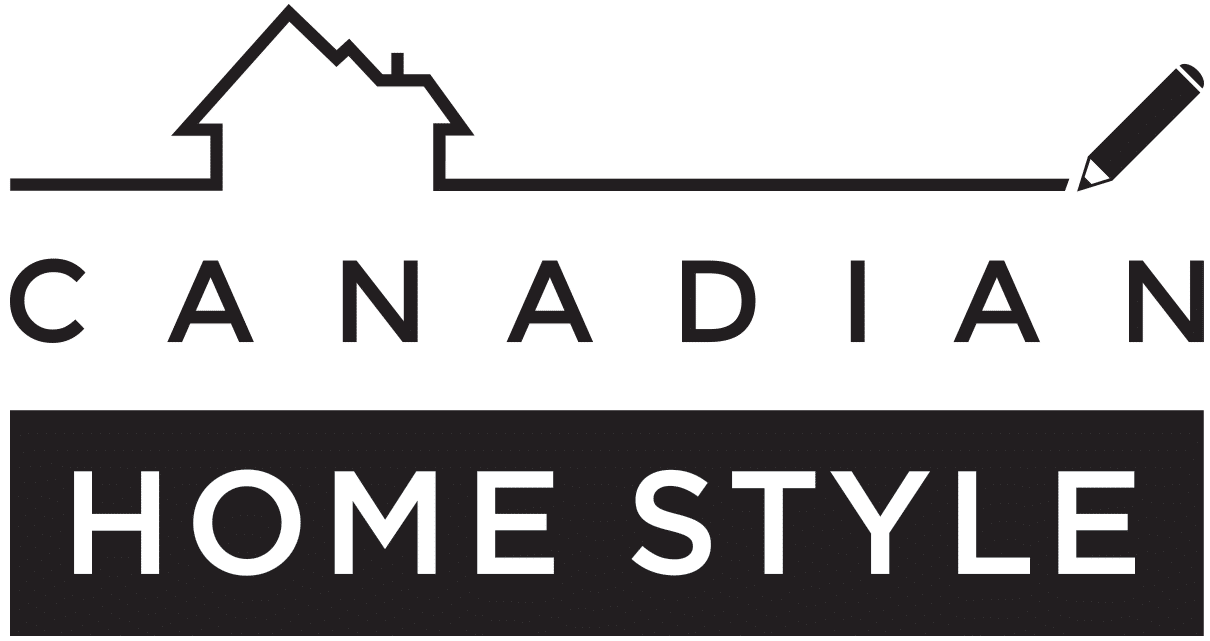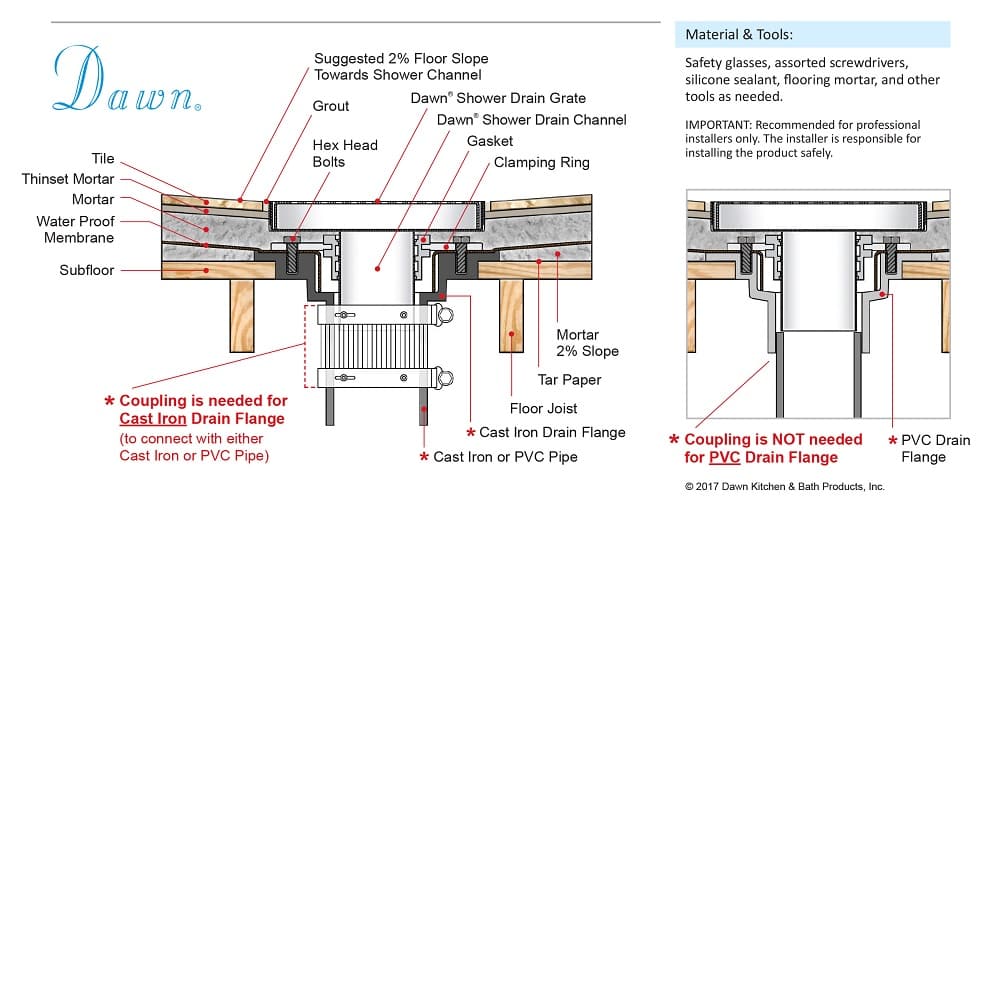
You’re renovating your bathroom and you’re wondering about your shower drain options. The most common mistake people make during shower drain installation is installing the wrong type of drain. There are many different types of drains to choose from, but the three most common types are Linear shower drain, Compression-style shower drain, and a Tileable grate. Let’s explore each of these types and how to properly install them. And don’t worry, because it’s easy. All you need to do is follow some simple instructions and you’ll be a pro in no time.
Understanding Different Shower Drain Types: A Comprehensive Guide
The world of bathroom renovations brings a variety of shower drain options, each with its unique installation process. Point drain systems, for instance, are commonly used in residential bathrooms. They are typically placed in the center of the shower area, efficiently channeling water through a single opening. Linear drains, on the other hand, offer a sleek and contemporary look. Their long, narrow design allows them to be placed along the shower wall or threshold, providing an efficient drainage solution while complementing modern bathroom aesthetics. Lastly, hidden drains, a relatively newer addition to the market, boast an invisible or concealed design, seamlessly integrating into the shower floor without disrupting the tile pattern.
Despite their various differences, these three categories of shower drains each offer their respective advantages, and the choice ultimately comes down to personal preference, assessing the bathroom layout, size and style.
Point drains are a popular choice due to their easy installation and straightforward function. They can effectively handle a large amount of water, and their location at the center of the shower equally distributes drainage, avoiding the accumulation of standing water. This central positioning, while functionally advantageous provides an opportunity for unique and decorative grates to become a focal point in the shower design.
Linear drains, oppositely, are primarily celebrated for their aesthetic appeal. The long, slim shape can create a minimalist and streamlined look, adding a touch of sophistication to the shower space. More practically, linear drains are also lauded for their diverse positioning options. They can be easily fitted along a wall or at the threshold, which not only gives flexibility in shower design but also simplifies the slope construction as the gradient only needs to slope in one direction towards the drain.
Hidden shower drains, while being the newest entrant in the market, are fast garnering attention for their seamless integration into any bathroom design. From a visual perspective, these drains can enhance the continuity of flooring as they conceal the drain beneath the surface. This camouflage creates a cleaner, uniform shower floor, making them an ideal choice for those wishing to maintain a consistent tile pattern across the whole bathroom. The only trade-off might be their complex installation process which may include an in-depth tile cutting job, but these challenges are often overshadowed by the aesthetic benefits these drains provide.
As you strategize your bathroom revamp or construction, it is essential to keep in mind these different drain options. Each offers unique benefits and drawbacks regarding aesthetics, functionality, and installation complexity. The best choice will align with your bathroom size, design, and the overall look and feel you aim to achieve. For more details on shower drain types, visit This Old House.
Linear shower drain
Linear shower drains are the preferred choice of modern homeowners. These drains can offer a number of benefits but proper installation is essential to ensure their performance. Here are some points to keep in mind:
First, measure the height of the shower floor. It should slope toward the linear shower drain so that it can be installed parallel to the entrance of the shower. Otherwise, it could cause a tripping hazard. Measure the height of the drain so that the top of the grate cover is an approximately one-eighth inch below the tile. After determining the height of the drain, install the grate cover and attach the linear shower drain.
The benefits of linear shower drains include more design flexibility. The linear design eliminates the need for a shower curb and the visual break in the floor. Additionally, the linear design maximizes the flow of water toward its exit port. Depending on the tile style, you can even customize the drain to accommodate a wheelchair or other mobility aid. This is a perfect option for aging-in-place bathrooms. The linear drain installation process is much simpler with linear drains than with center drains.
Schluter makes beautiful linear drains in a few different finishes and sizes depending on your style and shower size. That’s Canadian Home Style’s recommended line of linear drains.
Point shower drain
There are several steps that must be followed during a Point shower drain installation. First, clean the area and floor. The drain pipe should be free of debris during assembly. Use a pre-assembled sealing membrane or a cloth to protect the drain during the assembling process. Once the drain has been installed, ensure that the sealant has cured for at least 24 hours. Afterward, attach a metal grate over the top of the drain assembly.
If you want a shower drain that doesn’t cause water to pool, a linear drain is your best bet. This type of drain requires a single slope, whereas a center point drain requires all four sides to slope toward the center. This type of drain is also more expensive than a center point drain. However, they are easier to install, but it’s important to hire a plumber with experience with this type of drain.
Compression-style shower drain
Installing a Compression-style shower drain requires a few basic steps. Before tackling the installation, make sure you have the right tools and materials. One of the most important parts is the compression gasket, which must fit snugly over the drainpipe. To install this drain, you’ll need a screwdriver and silicone caulk. Make sure not to over-tighten the joints or the silicone may strip out. Once the drainpipe is installed, give the joints enough time to dry before using it.
Compared to other styles of drains, compression-style drains can be installed more easily. The drainpipes are attached to the compression-style assembly with compression nuts and washers. These drains are available in brass, ABS, PVC, and steel and work well with a variety of shower bases. Before starting the installation process, you should prepare rags and containers to clean up the mess. Moreover, you must have all the tools you need, including the drain ring and the screws.
Tileable grate shower drain
To ensure proper drainage, tileable grate shower drain installation requires waterproofing underneath thick-bed mortar. Tileable grate shower drains include linear rims. The linear grate is connected to a drain sub-assembly by means of clear weep holes. To install a linear grate shower drain, tileable grate drains must be installed at a slightly lower level than the floor tile.
In addition to the standard grate, the KERDI-DRAIN linear drainage system is designed for use with a Schluter KERDI-SHOWER tray. This drain can be installed adjacent to a wall or at an intermediate location. Its low-profile design makes it compatible with a variety of tile thicknesses and offers unique design opportunities. It is available in brushed nickel, copper/bronze, or stainless steel grate cover.
Step-by-Step Installation Process for Each Shower Drain Type
Installation processes vary significantly between different types of shower drains. For point drains, the process involves creating a slope in the shower base to guide water towards the drain. It’s crucial to ensure the drain is properly sealed and connected to the house’s plumbing system. Linear drains require a similar slope, but it should be directed towards one side of the shower. Precise measurements and cuts are necessary for a seamless fit. Hidden drains demand more intricate installation, often needing a custom-fit solution and careful consideration of the flooring material to maintain their concealed nature.
The process for installing a flush drain, on the other hand, is a little more complex. It calls for a deeper slope and precision because the drain must be positioned flush with the shower floor. Moreover, the surrounding tiles must be cut just right to ensure a perfect fit and to maintain a streamlined look. The watertight seal this type of drain requires is crucial to preventing water damage, particularly if your shower floor is made from a porous material like stone or ceramics.
When it comes to tile-in drains, the process requires a significant level of detail as well. In this method, the drain cover is replaced with a tile that matches the shower floor. Here, the installation process involves deep planning as the tile must be cut precisely to ensure it merges flawlessly with the drain and the shower floor. Every step, from preparing the shower base, planning the drain position, to fitting the tile-in cover, requires the utmost care to achieve the intended seamless look.
Lastly, when fitting a freestyle drain, the existing slope of the shower floor can be kept. This drain type can be located anywhere in the shower and thus delivers a high degree of flexibility during installation. However, it’s crucial to install a watertight seal properly and ensure the drain is well-connected to the plumbing system to avoid leakage problems in the future.
Regardless of the type of drain being installed, it’s crucial to understand the requirements and specifics of each installation process. Failing to do so may lead to various problems like poor water flow, unappealing aesthetics, and even dreaded water damage. Therefore, a thorough plan, attention to detail, and professional advice are always highly recommended when installing shower drains. Discover installation tips at DIY Network.
Choosing the Right Shower Drain for Your Bathroom Renovation
Selecting the ideal shower drain type hinges on several factors: the size and layout of your bathroom, your personal style preferences, and your budget. Point drains are versatile and cost-effective, fitting well in most traditional bathroom designs. Linear drains, while more expensive, offer a high-end look and are ideal for larger showers or bathrooms with contemporary designs. Hidden drains, appealing for their aesthetic, are best suited for custom-designed bathrooms where the drain can be seamlessly integrated into the floor design.
When considering the size and layout of your bathroom, it’s important to take into account the direction in which the water will flow and the size of the shower area. Point drains, placed in the center or corner of the shower, work well with any configuration, making them a practical choice for most bathrooms. These drains are typically less expensive, but also less decorative. However, they offer excellent functionality, being able to quickly and effectively channel away water.
On the other hand, linear drains are increasingly popular in contemporary bathroom designs due to their stylish and sleek look. They are best suited for larger showers, as they not only accommodate higher water flow but also add an architectural detail that can make the space feel more luxurious. While they are more expensive than point drains, many homeowners consider the splurge worthwhile for the aesthetic impact.
Finally, hidden drains provide a seamless look which is most desirable for high-end, custom-designed bathrooms. These drains are incorporated into the tile design, making them virtually invisible. They help in avoiding disruption of the bathroom floor design and can blend well with any chosen aesthetic. However, hidden drains require a more intensive, typically more expensive installation process, as the tiles must be precisely cut and laid to allow proper water drainage.
In terms of budget, point drains are the most affordable option, while linear drains are slightly more expensive. Hidden drains, while being the priciest, provide the most seamless aesthetic. To decide on the right shower drain type, you may need to balance these factors with your personal style preferences. For instance, if you value a sleek, modern look, you might be willing to spend more on a linear drain. On the contrary, if you’re operating on a tight budget but still want a functional and practical solution, a point drain might be your best bet. Explore more about choosing shower drains at Houzz.
Maintenance and Cleaning Tips for Shower Drains
Maintaining your shower drain is crucial for its longevity and efficiency. Regular cleaning prevents clogs and ensures smooth water flow. For point drains, removing and cleaning the strainer regularly is advised. Linear drains may require more frequent cleaning due to their design, with attention to the trough and grate. Hidden drains, while less prone to visible build-up, still need occasional maintenance to prevent internal clogging. It’s recommended to use natural cleaning agents to avoid damage to the drain and surrounding tiles.
In case you notice slower water drainage, it could be an early sign of a clog. Not addressing this issue could potentially lead to further problems, such as water accumulating during the shower. This could be uncomfortable for you, and over time, it may lead to other issues like recurrent water damage. Therefore, always be vigilant about any sign of a system failure.
Another vital part of maintaining your shower drain is taking measures to prevent hair, soap residue, and small objects from entering the drain. Integrating a hair catcher in your cleaning routine could be especially helpful if one or more people in your household have long hair. Actions like these significantly decrease the likelihood of experiencing blocked drains.
Equally, while most bar soaps are safe for your pipe, some contain ingredients that can stick to the interior of pipes and build up over time. In this case, switching to liquid or gel body soap may prolong the life of your shower drain.
If you encounter a stubborn clog that won’t yield to your cleaning methods, you may need to manually remove it. There are specialized tools like drain snakes or plumber’s augers for this task. As a precaution, make sure to avoid harsh chemicals as they could corrode your pipes and cause further problems.
Lastly, consider a routine professional inspection. Experts can detect minor issues before they escalate to severe problems. They have the skillset to detect the signs of a problematic drain that may not be apparent to an untrained eye.
By taking these few steps, your shower drain will operate effectively for many years to come. The best prevention is indeed regular and proper maintenance. Therefore, don’t allow minor problems to snowball into significant issues and compromise your drain’s functionality or your peace of mind. For maintenance tips, visit Bob Vila’s website.
Troubleshooting Common Issues with Shower Drains
Even with proper installation and maintenance, shower drains can encounter issues. Slow drainage often indicates a clog, which can be resolved with a plunger or a plumber’s snake. Odd smells from the drain might suggest a dry P-trap, which can be fixed by running water to refill it. If leaks occur, it’s essential to address them promptly to prevent water damage. Consulting a professional plumber is recommended for complex issues or installations.
Furthermore, knocking sounds coming from your pipes could signify water hammer, a condition that arises when water shuts off suddenly and causes your pipes to vibrate. This can be fixed by installing water hammer arrestors, though calling in a professional is recommended for this job. Also, keep an eye out for persistent dampness or water on your bathroom floor – this could be due to a leak from the shower pan.
Another common problem is a running toilet, which often occurs when the flapper seal within the toilet tank is damaged or worn out. To fix this, you should replace the flapper or install a new toilet fill valve. Again, for those who are not comfortable with DIY repairs, hiring a licensed plumber could save you from aggravating your existing home plumbing issues.
Remember that drain grates can also degrade over time due to exposure to water and the chemicals found in various cleaning products. If you start noticing damage to your drain grates, it’s crucial to replace them immediately to prevent larger debris from clogging your pipes.
In the event where your shower drain begins to exhibit persistent problems despite your best efforts at maintenance, it could be a sign of more severe issues like pipe corrosion or tree root invasion. Should these complications arise, professional intervention becomes imperative.
Lastly, if you live in an older home, beware of outdated plumbing systems that may be prone to systemic issues or perhaps not up to current codes. Having a professional plumber carry out routine inspections of your plumbing system can go a long way in preventing unwanted surprises and costly repairs. For troubleshooting help, check out Plumbing Help Today.
Enhancing Bathroom Aesthetics with the Right Shower Drain
The choice of shower drain can significantly impact the overall look of your bathroom. Point drains offer a classic look, while linear drains add a touch of modern elegance. Hidden drains, by virtue of their design, maintain the continuity of your floor tiles, offering a clean, uninterrupted look. When selecting a shower drain, consider how it complements your bathroom’s tiles, fixtures, and overall style.
Further, it is also important to consider the practical aspect of the shower drain along with its aesthetic appeal. Depending on the design and size of your shower, some drains may be more functional and efficient than others. For example, linear drains can handle a larger volume of water and are therefore well-suited for larger showers or showers with a higher water flow. Meanwhile, point drains are perfect for small-to-medium-sized showers and are generally more cost-effective.
Specific shower drain materials also play a crucial role in the longevity of your shower. Drains made of stainless steel or brass tend to be durable, rust-resistant, and easy to clean. Choose a finish that matches with your other fixtures, whether it is a bright chrome, a brushed nickel, or a rich oil-rubbed bronze.
Installation complexity is another aspect to bear in mind. Hidden drains usually require professional installation due to their intricate design, and they may not be compatible with all types of flooring. Point and linear drains, on the other hand, are easier to install and can be a suitable DIY project for the experienced homeowner.
Lastly, user safety is a crucial factor. Some drains may become slippery when wet, posing a potential fall risk. Opt for a shower drain with a slip-resistant surface to ensure the safety of users. Get design inspiration from Architectural Digest.
The Environmental Impact of Shower Drain Selection
Choosing an eco-friendly shower drain can contribute to water conservation and sustainable living. Some modern shower drains are designed to minimize water wastage, helping in water conservation efforts. Additionally, selecting materials that are recyclable or have a lower environmental impact, such as stainless steel or recyclable PVC, can make your bathroom renovation more eco-friendly.
Furthermore, prevention of mold and mildew growth is another advantage of eco-friendly shower drains. These types of drains usually have built-in mechanisms that allow water to drain quickly, reducing the amount of standing water that can breed harmful bacteria and fungi.
Another thing to consider in regards to eco-friendly shower drains is ease of maintenance. Drains made from recyclable PVC or stainless steel are not only better for the planet, but they’re also much easier to clean and maintain. Furthermore, they often come with removable hair catchers to prevent clogs, reducing the need for harmful chemical drain cleaners, which are hazardous to the environment.
Features such as water-saving shower flow rates can also make a big difference in conserving water. Some eco-friendly shower drains come equipped with flow restrictors that can significantly reduce the amount of water used during a shower without compromising the user’s comfort.
When you’re choosing a shower drain, it’s also worth considering the manufacturing process. Companies that prioritize sustainability and environmental stewardess will often use manufacturing processes that require fewer resources and cause less pollution. These companies may also use green packaging, which further minimizes the product’s carbon footprint.
Moreover, investing in an eco-friendly drain can lead to long-term cost savings. Though the initial outlay might be more, you’ll find the running costs to be less over time with lower water bills and fewer maintenance requirements. Learn about eco-friendly bathroom solutions at Green Building Supply.
Key Considerations Choosing Shower Drains For Your Bathroom in Metro Vancouver.
1. Expertise in Bathroom Renovation and Plumbing:
The foremost consideration is the business’s expertise in bathroom renovations, especially their knowledge of different types of shower drains such as linear drains, point drains, and hidden drains. A company experienced in “bathroom remodeling,” “plumbing solutions,” and “shower installation” is more likely to provide quality service. It’s essential to check their proficiency in handling “modern shower designs” and “custom shower installations,” as these require specialized skills.
2. Quality of Materials and Workmanship:
The quality of materials used for “shower drain installation” is crucial. A business that sources “high-quality stainless steel drains” or “eco-friendly PVC materials” indicates their commitment to durability and sustainability. Additionally, their workmanship, especially in “tile alignment,” “waterproofing,” and “sealant application,” plays a vital role in the longevity of the shower drain.
3. Customization and Design Options:
Understanding the range of “design options” offered by the business is essential, especially if you’re looking for a “custom shower solution.” This includes their ability to integrate “aesthetic considerations” in their work, like matching the shower drain with the “bathroom’s interior design” and “tile patterns.” Businesses that offer a variety of “drain styles” and “shower floor designs” provide more flexibility in aligning with your bathroom’s overall look.
4. Cost-Effectiveness and Budget Considerations:
While cost should not be the only determining factor, it is an essential consideration. It’s important to evaluate if the business offers “competitive pricing” without compromising on the quality of materials and installation. Seek out businesses that provide “transparent cost estimates” and avoid those with hidden charges.
5. Customer Reviews and Reputation:
Checking “customer reviews” and assessing the company’s reputation in the “home renovation industry” can provide insights into their reliability and quality of service. Look for reviews mentioning “timely completion,” “professional conduct,” and “post-installation support.”
6. Compliance with Local Regulations:
Ensure that the business adheres to “local building codes” and “plumbing regulations.” This is crucial for ensuring that the installation process is compliant and avoids future legal complications.
7. After-Sale Support and Warranty:
Finally, consider the after-sale support offered by the business. A company that provides a “warranty on installation” and “after-sale service” is indicative of their confidence in their work and commitment to customer satisfaction.
Choose Canadian Home Style for your Vancouver Bathroom Renovation.
Canadian Home Style is your family-owned and operated bathroom remodeler in North Vancouver, BC. We hold the highest standards in the industry and provide complete bathroom renovations across the Lower Mainland with an extended warranty. We always keep up to date with the latest trends and are proud members of the NKBA National Kitchen and Bath Association. In addition, we have won the Consumer’s Choice Awards back-to-back in 2021, 2022, 2023, and 2024 for our commitment to business excellence. We are considered one of Metro Vancouver’s highest-rated kitchen and bath design and renovation experts. Book now to visit our North Vancouver showroom, where you can get expert advice from one of our kitchen and bath designers. We’re happy to be a part of your journey with your next bathroom renovation project in Metro Vancouver.
Our mission is to help homeowners create beautiful homes that reflect their lifestyles while reducing energy consumption and conserving resources. We provide our clients with innovative products, services and education. We aim to become Canada’s leading sustainable kitchen and bath design and renovation provider. Our values include integrity, respect, honesty and transparency. These principles guide us as we strive to provide outstanding customer service.
We believe that our success depends on the success of our clients and their customers. We work hard to ensure our clients get the most out of their investments. Our team consists of highly skilled professionals who are experts in their field. They have years of experience working together and know what works and what doesn’t. They understand how to solve problems quickly and efficiently. We are committed to providing excellent customer service. We listen carefully to our client’s concerns and suggestions. We take these into account when planning and executing projects. We always strive to exceed expectations.
Why Choose Us?
1. Specialization in Canadian Plumbing Standards: Canadian Home Style is deeply versed in the plumbing standards and practices specific to Canada. This expertise is vital because Canadian plumbing regulations might differ from those in other countries, especially regarding drainage systems and water conservation. Their understanding of local codes ensures that all installations are compliant and efficient, reducing the risk of future plumbing issues.
2. Use of High-Quality Sealants and Powder Coating: In the wet environment of a shower, the quality of sealants used is critical. Canadian Home Style uses superior sealants that provide long-lasting protection against water leakage and mold growth. Additionally, their use of powder coating in drain finishes offers a durable, rust-resistant, and aesthetically pleasing solution. Powder-coated finishes are especially suitable for the damp, variable climates found in many parts of Canada.
3. Expert Gasket Installation: The role of a gasket in shower drain installation is crucial for preventing leaks. Canadian Home Style’s professionals are skilled in selecting and installing the right gasket for each specific job, ensuring a watertight seal. Their attention to this detail is a testament to their commitment to quality and durability in their installations.
4. Proficiency in Creating the Perfect Slope: A critical aspect of shower drain installation is ensuring the correct slope towards the drain to prevent water pooling. Canadian Home Style’s team has the expertise to create the ideal slope in your shower area, ensuring efficient water drainage and enhancing the overall shower experience.
5. Use of Advanced Materials like Fiberglass and Acrylic Resin: Canadian Home Style stays ahead in the market by using advanced materials like fiberglass and acrylic resin in their installations. These materials are known for their durability, ease of maintenance, and aesthetic appeal. They offer a modern look to any bathroom, aligning with various design preferences.
6. Specialization in Metro Vancouver Regional District: Being based in the Metro Vancouver Regional District, Canadian Home Style understands the specific needs and preferences of the local community. Their experience in this region equips them to handle the unique challenges posed by the local climate and housing styles.
7. Incorporation of Solvent and Percussion Cap Techniques: Innovative techniques such as the use of solvents for seamless pipe fittings and percussion caps for precise installation demonstrate Canadian Home Style’s commitment to using advanced technology in their installations. These techniques ensure a higher quality of work and longer-lasting results.
8. Custom Shower Solutions: Canadian Home Style excels in providing custom shower solutions. Whether it’s a specific shower design, unique drain type, or a particular aesthetic, they work closely with clients to bring their vision to life. Their ability to tailor solutions to individual preferences sets them apart in the market.
Services We Offer:
Main Areas of Service in British Columbia:
- Vancouver
- North Vancouver
- West Vancouver
- Burnaby
- Coquitlam
- Squamish
- Whistler
Did you miss our previous article…
https://canadianhomestyle.com/bathroom-renovation/modern-bathroom-vanity-sinks/






